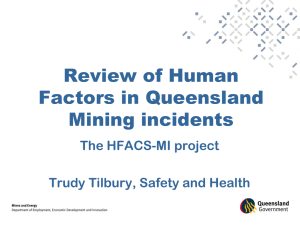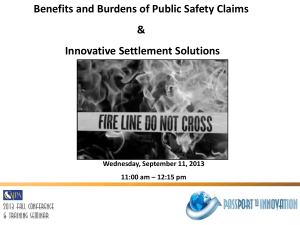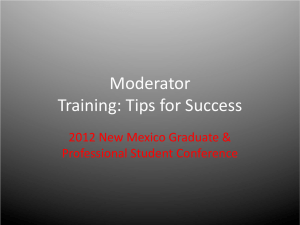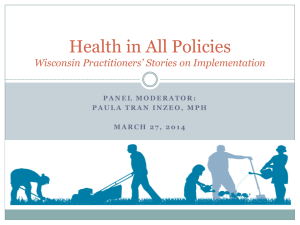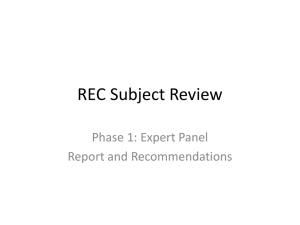Managing the QME Process - The California Comp Blog
advertisement
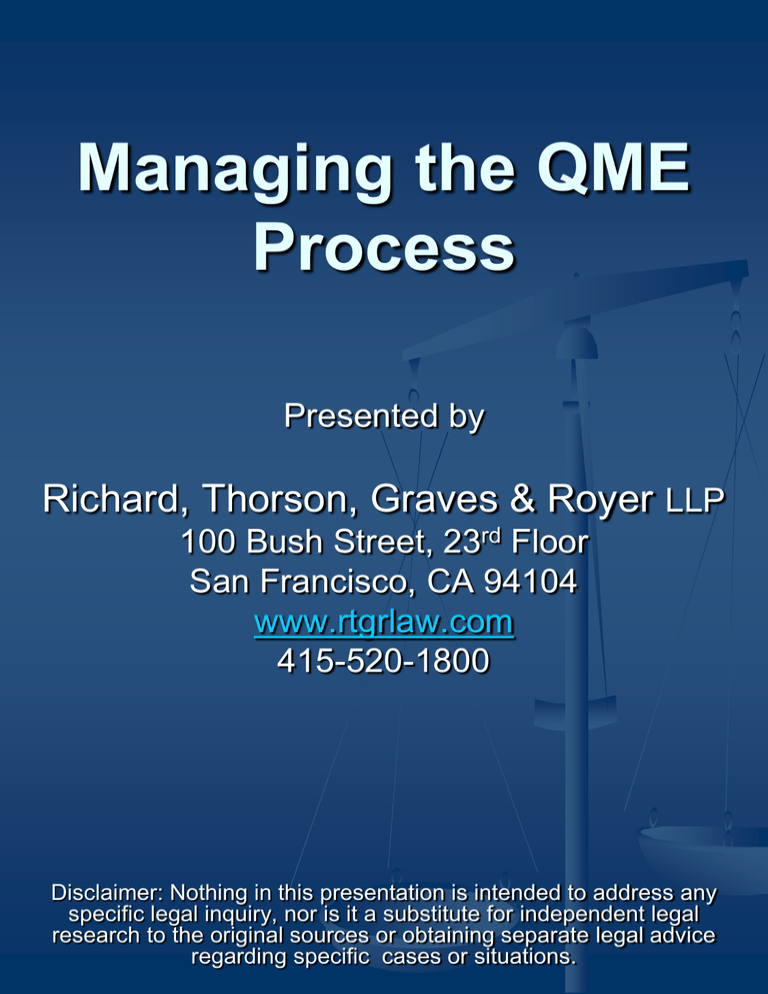
Managing the QME Process Presented by Richard, Thorson, Graves & Royer LLP 100 Bush Street, 23rd Floor San Francisco, CA 94104 www.rtgrlaw.com 415-520-1800 Disclaimer: Nothing in this presentation is intended to address any specific legal inquiry, nor is it a substitute for independent legal research to the original sources or obtaining separate legal advice regarding specific cases or situations. The issues: Strict time limits apply to the QME process, from the initial objection through the final reporting from or deposition of the QME doctor. Some parties try to use the QME rules to “game” the process and “doctor shop.” Certain disputes are subject to remedies and processes other than the AME/QME process. Any ex-parte communications are prohibited and dangerous. The Medical Unit issues the panels, and they are backed-up and often non-responsive. The law is unsettled and constantly changing on many fronts, including both regulations and case law. What is not part of the QME process? UR process is mandatory and is the only way to delay, limit or deny proposed treatment. Sandhagen 73 CCC 981. Employer cannot object under LC 4062 to treatment that is subject to UR; only the employee’s timely objection to a UR decision can start the AME/QME process. Spinal surgery requests: Must be submitted to UR and separate 2nd opinion 4062(b) process using DWC form 233; UR non-certification must be completed and 2nd opinion request must be submitted, within 10 days of receipt of surgery request, per Cervantes and Elliot cases. What is not part of the QME process? Treatment objections within MPN are generally subject to the 2nd/3rd opinions process for employees, and the UR process for employers: Employee can only object to the PTP’s diagnosis or prescribed treatment through the 2nd/3rd opinion processes in the MPN; cannot object under LC 4062(a). Employee’s objection to a PTP’s discharge from care is only subject to the QME process, not the 2nd/3rd opinion processes, per Rule 9785 and Tenet. However, the employee can change PTP in the MPN any time. Employer must use UR to object. What disputes are covered by the QME process? Disputes regarding TD or PD per LC 4061/4062. Employee’s objections to a UR modification, delay or denial of treatment per LC 4610 & 4062(a). Notice from a UR report that there is a “part of body” dispute. Simmons case. AOE/COE and compensability disputes per LC 4060. Most other medical treatment disputes (LC 4062). QME Curiosities To be a valid medical-legal expense, a QME report must be capable of proving or disproving a disputed material fact, essential to the employee’s claim. LC 4620(c). The parties have a duty to notify each other of medical exams. Rule 10430. The WCJ and the WCAB are empowered to order QME exams, independent of the 4061/4062 process, per Rule 32.6. All medical-legal reports must comply with LC 4628, and failure to fully comply makes the report inadmissible. Rule 10606 is broader, applies to all reports, and violations go to weight of the evidence. QME Qualifications Must disclose certain financial interests to the parties. Rule 29. Must be available. Rule 33. Disclose date/address of exam in the report. Rule 35.5. QME medical treatment recommendations should be consistent with ACOEM. Rule 35.5(g). Must be available for a deposition within 120-days, at the location of the exam. Rule 35.5(f). QME is bound to strict ethical and conflict-of-interest rules, 41 & 41.5, and cannot accept gifts. 41.7. QME Exam Termination At the beginning of the actual exam, the QME shall disclose to the employee that the exam can be discontinued for good cause: Discriminatory conduct; Abusive/hostile behavior; Unnecessary exams/procedures. If required by the AD, QME shall disclose if he/she is on probation. If the employee does not object to going forward on any of those grounds during the exam itself, the employee cannot later object to the report based on any of those grounds. QME Exam Termination If the employee terminates an exam alleging: ex parte communication; good cause; scheduling issues (rule 41a); or conflict of interest, and the WCJ later determines it was false, the cost of the exam shall be deducted from the employee’s Award. Rule 41(g). A true violation of the disclosure, ethical or conflict-of-interest rules by the QME resulting in termination of the exam, means that no party is liable for the costs of the exam. Rule 41(g). Conflicts of Interest An examining physician’s disqualifying conflicts-ofinterest include: Familial/cohabitation; Significant financial interests (e.g., co-owners of business practice); Referral sources; Professional affiliation (same medical group or business entity– MPN’s excluded); Anything else impinging on integrity or impartiality of the examiner. Rule 41.5(d) Conflicts of Interest The persons/entities covered by the conflict of interest rules include: Employee & his/her attorney; Employer & attorney; Adjuster, insurer, TPA & attorney; PTP & secondary treater; UR reviewer & UR organization; Surgical Center used or proposed in the case, if surgery disputed; Any other purveyor of medical goods or services, if that good/service disputed. Rule 41.5(c) Conflicts of Interest If the employee is represented, the parties can waive the conflict of interest. Rule 41.6(c)(2). If unrepresented or if there is no joint waiver in a represented case, a replacement QME panel shall issue. Rule 41.6(b) & (c). No AME or QME shall accept gifts in the aggregate of $360 or more from any single source within 12 months, including any: WC attorneys; physicians; employers; claims adjusters; or medical, health care, UR or insurance entities. Rule 41.7. Compensability Disputes There is no time limit for seeking a panel QME to address compensability under LC 4060. Either party can request a QME after delay or denial of the claim of injury. If unrepresented, follow LC 4062.1 procedure; if represented, follow 4062.2. Rule 30(d)(3) barring employers from requesting a compensability exam anytime after the 90-day investigation period or the denial of the case, was struck down by the WCAB in Mendoza v. Huntington Hosp. (en banc) 75 CCC 634. Compensability Disputes Workers’ comp claims can be denied for lack of medical substantiation of injury if there is no treating doctor report finding injury AOE/COE and no QME has been requested by the employee. If a QME report is needed by the employer or was requested by the employee to address compensability, but cannot be reasonably obtained within the 90-days, despite due diligence, that may be a separate basis for denial. PD Disputes If the parties cannot agree on the PD rating based on the treater’s evaluation, either party may request a QME to address PD, per LC 4061(c) & (d). If the employee is represented, follow LC 4062.2 procedure. If unrepresented, follow LC 4062.1 procedure. There is no time limit to begin the AME/QME process if there is a dispute over PD. However, there are strict notice requirements for the delay or denial of PD. LC 4061(a) & (b). PD Disputes Either party may request a QME to determine PD, but in an unrepresented case, the QME shall not issue any supplemental report in response to a party’s request re: PD or apportionment until after the DEU has issued a summary rating. Rule 36(e). A request for rating of the supplemental report must be made within 20 days of receipt. Rule 10160(f). Medical reports, other than treating physician reports, obtained in violation of 4062.1 and 4062.2 are inadmissible as evidence. LC 4061(i). Medical & TD disputes Disputes over certain medicallegal issues are subject to LC 4062, including: Discharges from care by the primary treater, per Rule 9785(b)(3) and Tenet; TD or Parts of Body; UR determinations: The employee must object in writing within 20 days of receipt of the contested UR determination, per LC 4610 & 4062(a), unless good cause is shown or there is mutual agreement. Upon objection, employer must provide employee with form 105. Medical & TD disputes Upon receipt of the disputed medical report from the treating physician, the objecting party must notify the other in writing within: 20 days, if employee is represented; or 30 days, if unrepresented. There cannot be an AME agreement with a pro per employee. 4062.1(a). In unrepresented cases, the QME request shall be submitted on QME form 105; in represented cases, form 106. Unrepresented Process Along with any timely objection, the employer should furnish the employee with panel QME form 105, per 4062.1(b). If the employee does not submit the panel QME papers within 10 days of receipt of form, the employer may submit form 105 and designate the specialty. Must be submited by mail to Med Unit with proof of 4061/4062 compliance. If the employee does not inform the employer of their selection within 10 days of the assignment of the QME panel, the employer may select the QME and schedule the exam. 4062.1(c). Unrepresented Process If the employee informs the employer of the selection but does not set the exam, the employer shall set the exam with the employee’s chosen evaluator. LC 4062.1(c). The employer must forward travel expenses upon receipt of the notice. If employee later becomes represented, and the actual QME exam has not yet taken place, he/she can choose a new QME panel. Romero v. Costco 72 CCC 824. Represented Process For dates of injury prior to January 1, 2005, each party may obtain their own QME. Simi v. Sav-Max Foods (en banc) 70 CCC 217. For dates of injury on or after January 1, 2005, either party must offer at least one AME name, in writing, and the parties have 10 days to agree (or 20 days by extension), per LC 4062.2. Only thereafter can either party request a panel QME using form 106. LC 4062.2(b). At least one Judge in Oakland has held that the 10 days are extended by 5 days for mailing, but a contrary opinion is found in Alvarado 72 CCC 1142. A QME request submitted prematurely may be rejected by Med Unit. Represented Process The party submitting form 106 shall designate the specialty and list the choice of the opposing party, if known, and the specialty of the treater, and shall serve it on the other party. LC 4062.2(b). Attach a copy of the AME solicitation letter. If the Medical Unit receives 2 or more 106 forms on the same day designating different specialties, the panel shall issue in the same specialty as the PTP, if requested by either party. Rule 31.1(a). Otherwise, any specialty appropriate to the disputed medical issue can be assigned. Represented Process If a party designates a QME panel specialty other than the PTP’s, the party shall submit with form 106 any relevant documentation supporting the reason(s) for the other specialty. Rule 31.1(b). If the Medical Unit is unable to issue a QME within 30 days of receiving the request, either party may seek an order from the WCJ. Rule 31.1(c). Said order shall specify the specialty or the party designated to select the specialty. Any specialty appropriate to the injury is fair game, per Judge Padilla. Represented Process Within 10 days of assignment of the panel of QMEs, the parties shall confer and attempt to agree on an AME from the list. If no agreement by the 10th day, each party may strike one name, and the remaining doctor shall be the QME. LC 4062.2(c). If a party fails to exercise the right to strike within 3 working days of gaining the right to do so, the other party may select the QME. Advice: strike by fax & mail, and do so within 10 days of receipt, or within 3 days of the other party’s strike date, whichever occurs first. QME Timelines: Exam The employee shall set the exam, but failing to do within 10 days, the employer can set the exam. 4062.2(d). The QME must schedule an exam within 60 days of the initial request, Rule 31.5(a)(2). Time can be extended to 90 days if allowed unilaterally by the party with the legal right to schedule the exam. Rule 33(e). Both parties can agree in writing to waive the 90 day limit. Exam must take place only at the office address listed on the QME panel notice. Rule 34(b). QME Timelines: Exam If an exam cannot be set within the 60 (or 90) day time limits, either party may request a replacement QME doctor to the panel. Rule 33(e). The QME must serve notice of the exam on the parties within 5 business days of the scheduling of the exam. Rule34(a). QME exams cannot be cancelled by the doctor less than 6 business days before the exam, except for good cause. Rule 34(h). Failure to receive relevant records is not good cause to cancel. Rule 34(g). QME Timelines: Reports The panel QME must complete the initial or follow-up medical-legal evaluation report and submit it not more than 30 days after the exam. Rule 38(a). May be extended by 30 days for receipt of test results, or 15 days for good cause per LC 139.2(j)(1)(B), such as medical emergencies, natural disasters, and the like. Rule 38(b). Extension requests shall be made on QME form 112, at least 5 days prior to the 30-day deadline. QME Timelines: Reports If untimely, either party can request a QME replacement. Neither is liable for the costs of the untimely report, absent mutual waiver. Untimely report may be inadmissible as evidence. No extension of the QME timeline for lack of medical information or records. Rule 38(g) Supplemental reports are due within 60 days from the date of the written request to the physician by a party. Rule 38(h). Parties can agree to extend the time by up to 30 days. Untimely response may cause the QME’s opinion to be thrown out. QME Communications Any party may provide the PQME with records from treating physicians, as well as other medical and relevant non-medical records. LC 4062.3(a). Sub rosa films and personnel file documents may be relevant. Proposed information must be served on the opposing party 20 days before it is provided to the QME. LC 4062.3(b). The service should include a letter with a log or list of items that will be given to the QME absent objection in 10 days. Diary the case to send to the QME on the 11th day absent an objection. QME Communications If opposing party objects to nonmedical records within 10 days of service, those records shall not be provided. Either party may use discovery to establish accuracy /authenticity of the nonmedical records. Presumably, those disputes can be heard by the WCJ. Also, these limits don’t apply to the content of QME cover letters. QME cover letters must be served simultaneously on opposing party, and must be sent at least 20 days before the evaluation. LC 4062.3(e). Ex Parte Communications Ex parte communication with the QME is prohibited. LC 4062.3(f). Aggrieved party may elect to terminate the evaluation and seek a new QME. Offending party may be found in contempt and shall be liable for exam costs and attorneys fees. Ex parte communication does not include communications between the employee and examiner, 4062.3(h), even 6-weeks after the exam, per Koeing v. AT&T 39 CWCR 37. Calling to arrange an exam is probably not prohibited, but doing so without notice to the other side is. State Farm v. WCAB (Pearson) 76 CCC 69. Replacement QMEs Replacement QMEs or replacement panels shall be selected at random, per Rule 31.5, for 16 different grounds, including: Untimely exam scheduling; Untimely report, and a party objected in writing due to lateness prior to the date of service of the report, 31.5(a)(12); Employee changed residence address; Two doctors on the panel are in the same practice group, or one is the PTP; Parties agree in writing; Conflict of interest; “Good cause” found in WCJ order. If a party objects to a report for any reason only after receipt, that may be disallowed as “doctor-shopping.” Fajardo v. WCAB 72 CCC 1158. Additional QMEs Additional issues that arise shall, to the extent possible, be submitted to the same QME, per LC 4067 and Rule 31.7(a). An new QME in a different specialty can be assigned for good cause if needed, and if: Ordered by a WCJ, which includes a finding that it is reasonable & necessary to resolve a disputed issue, per Rule 32.6; Requested by QME after advising the parties; There is written agreement by the parties and no AME could be reached; Requested by the I&A officer in an unrepresented case using form 105. Consult QMEs A consult QME cannot be requested solely to obtain an opinion regarding PD and apportionment. Unless the referring QME is an acupuncturist. Rule 32(d). A referring QME may refer to a “consulting physician,” as to treatment issues, if the parties have not selected an additional QME from a panel. Rule 32(d). May not need to be a QME, but needs to comply with reporting time limits ; Referring QME must notice all parties with form 110; Conflict of interest rules may apply; QME must adopt and incorporate consult report. Rule 32(e). Can be deposed. Rule 32(g). Subsequent Issues Per Rule 35, to the extent possible, the parties should return to the same QME for: Follow-up exams; New medical issues, including a reopening of the claim; Subsequent injuries claimed to the same part of body and all the parties are the same. If the QME is unwilling or unable to be timely deposed regarding his/her opinion, it will likely be thrown out. WCJ can order employee to appear at a QME exam. Thank You! For more information, please visit our website: www.rtgrlaw.com Sign up for automatic legal updates on our blog: www.CaliforniaCompBlog.com Or call us: 415-520-1800
